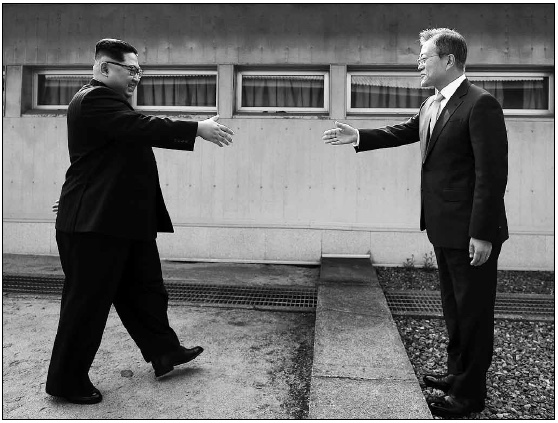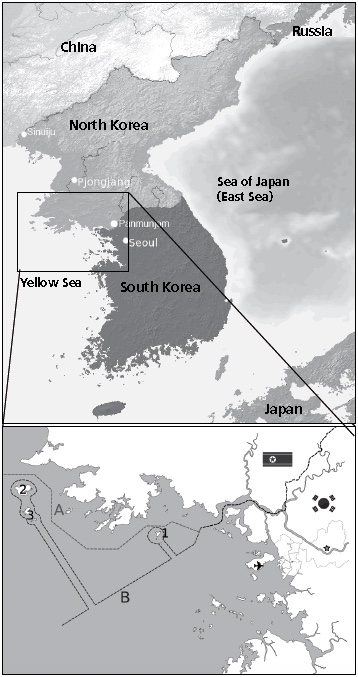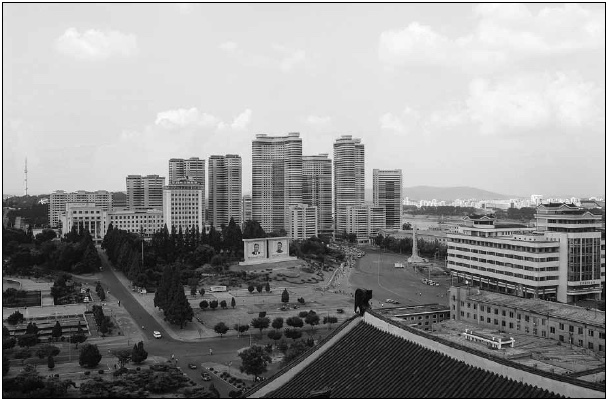Korea and the power interests of geopolitics
Korea and the power interests of geopolitics
Some fragments on the history of the Korean peninsula
by Erika Vögeli and Peter Hediger*
It is rather difficult for us to assess the importance of the content of the Panmunjeom Declaration for the people of the Korean peninsula. However, a very cursory look at history reveals that this country and its people – occupied more than 100 years ago and being an area of geopolitical conflicts for decades – have never given up on regaining their sovereignty and independence and living together as a united nation.
The following statements are by nature incomplete and are only intended to remind you of a few important stages.

After Japan’s victory in the war against China in 1894/95, the Kingdom of Korea, until then in a vassal relationship with China, came under the domination of the Japanese empire, which entirely annexed it in 1910.
Japan – an ally of the German Empire during the Second World War – surrendered in 1945. It could no longer withstand a double pressure: After the end of World War II in Europe, Stalin opened a new front in East Asia against Japan. The two US missions using nuclear weapons in Hiroshima and Nagasaki quickly brought Japan to its knees. At a hastily convened meeting in Moscow, the Soviet Union and the USA decided to disarm the remaining Japanese forces in Korea. The 38th parallel was defined as a provisional border barrier. In the north of this line the Soviet Army was responsible for the disarmament and the US forces in the south.
The Cold war ends any hopes for reunification for the moment
At the Yalta Conference in 1945 it was decided to hold elections in Korea within 5 years to give Korea the opportunity to become an independent country with its own elected government. The mandate for these elections, which were originally intended for the whole of Korea, was taken over by the UN in 1947. Increasing contradictions among the former allies led to the Cold War and from 1950 – 1953 to a direct armed conflict on the Korean peninsula. Even after a ceasefire was concluded, the major powers involved in Korea continued their efforts to consolidate their spheres of influence on the Korean peninsula, hardening the military demarcation line along the 38th parallel.
On 10 May 1948, the USA held elections in South Korea and declared Rhee Syng-man as winner. Rhee was part of the resistance against Japanese colonization and spent decades first in Chinese and then in American exile. He took over the affairs of state from the USA on 13 August and proclaimed the Republic of Korea on 15 August. In response, Kim Il Sung, supported by the Soviet Union, proclaimed the Democratic People’s Republic of Korea on 9 September 1948.
America had meanwhile invested large amounts of money in South Korea – at that time in about half of all mines, railways, banks and the fertile part of the country were supposed to have been taken over by US companies. Nevertheless, the North initially developed more rapidly and showed stronger economic growth than South Korea until the beginning of the 1970s.
Initially, Korea had a short common border of 14 kilometres with the Soviet Union only in the north-east. In 1949, the Communist Party under Mao Zedong gained power on the Chinese mainland and also proclaimed a Communist People’s Republic, making the entire Korean peninsula border along the Yalu and Tumen rivers abutting the socialist block and turning North Korea into a strategic apron or buffer zone. At the demarcation line across the peninsula, which also ran along about the 38th parallel, the two Cold War blocks stood directly opposite each other in Korea from then on.
Korean War:
First proxy war of the bipolar world
The Korean War of 1950 – 1953 is considered the first proxy war in the bipolar world of the Cold War. The USA first denoted the Soviet Union as the driving force, later Kim Il Sung was regarded as the person mainly responsible. Modern historians have become more cautious with such one-sided accusations and interpret the North Korean offensive as a reaction to a South Korean provocation. Kim Gu, a long-time companion of Rhee Syng-man in Chinese exile, made a final attempt to overcome the division of Korea in 1948 with a visit to Kim Il Sung in Pyongyang. Returning to Seoul, he was murdered at the behest of Rhee Syng-man.
The USA used the absence of the Soviet delegation in the Security Council to intervene militarily on behalf of the UN on the Korean peninsula. After initial successes of North Korea, US troops advanced to almost the border of China, which felt threatened accordingly and supported North Korea by sending so-called people’s volunteers. China was thus able to avoid an official entry into the war and the involvement of its own country as a war participant. Nevertheless, the American commander-in-chief General MacArthur advocated the use of nuclear weapons against China and the occupation of northeast China (Manchuria), which bordered Korea, an important economic region for China. For the first time, the world was confronted with the growing risks of war of two nuclear powers. Even President Truman got spooked, so he prematurely dismissed MacArthur.
The war went on with tremendous brutality. Paramilitary communist underground troops murdered opponents of the North Korean regime in South Korea and practiced a policy of scorched earth. Conversely, in South Korea, an anti-communist hysteria resulted in mass executions of communist supporters; US troops killed countless civilians, often including families and children, suspecting them of collaborating with the Communists.
In North Korea, in particular the US bombing caused devastating damage. 450,000 tons of bombs, 32,357 tons of which were using napalm, were dropped on North Korea. The consequences were devastating, because unlike in Vietnam, North Korea had more densely populated conurbations with industry.
At least half of the 22 largest North Korean cities were razed to the ground. It is estimated that South Korea lost about one million people, North Korea 2.5 million and China one million.

27 July 1953: ceasefire only
After diplomatic contacts between the USA and the Soviet Union from 1951 onwards in Warsaw and Geneva, negotiations began between the warring parties in Panmunjeom, which led to a ceasefire not until 27 July 1953, but without South Korea ever having co-signed this agreement. This gives additional importance to the inter-Korean summit between Chairman Kim Jong Un and President Moon Jae-in in Panmunjeom on 27 April 2018.
The 1953 agreement essentially confirmed the 38th parallel as the border between North and South Korea and established a four-kilometer wide demilitarised zone along the border. It was administered by the Military Armistice Commission MAC, while the Neutral Nations Supervisory Commission NNSC has the mission of monitoring it. In addition, a Neutral Nations Repatriation Commission, of which India was a neutral member, was responsible for the repatriation of the prisoners. This commission was dissolved in 1956. The neutral countries mentioned were Sweden and Switzerland as well as Poland and Czechoslovakia. Following the fall of the Iron Curtain, Poland and Czechoslovakia withdrew their delegations in 1993 on the initiative of North Korea. To date, five Swiss and five Swedish officers are permanently stationed in Panmunjeom for the NNSC. A Polish representative resides in Seoul today. The NNSC has not been recognised by the North since 1993. In the same year Pyongyang also achieved the withdrawal of the delegation of the Chinese People’s Volunteers in the Military Armistice Commission from Kaesong/Panmunjeom. The repatriation of the Chinese people’s volunteers was already completed in 1958.
US military presence to this day
In contrast, the USA still has a military presence of 28,000 troops in South Korea. To this day, the South Korean army will be under the command of the responsible US general in the event of war. The ceasefire agreement should have been replaced by a peace agreement after one year. While the US has so far refused to sign a peace agreement because it would then have to withdraw its troops from South Korea, North Korea considers the ceasefire agreement with its institutions of the Military Armistice Commission and the Neutral Nations Supervisory Commission as anachronistic and obsolete.
Soon after the 1953 ceasefire agreement was concluded, it was repeatedly and in some cases seriously violated. It is impossible to list all incidents and blames here. Instead, a few selected relevant incidents from more recent times should be remembered:
Northern Limit Line – arbitrary demarcation of the United Nations Command
- Since 15 June 1999, there have been repeated heavy sea battles in the Yellow Sea (Korean name: West Sea) south of the island of Yeonpyong held by South Korea. The reason for this are different opinions about the course of the sea border. Immediately after the conclusion of the ceasefire agreement the United Nations Command, the war party on the south side, arbitrarily introduced a Northern Limitation Line as a sea border immediately off the North Korean coast. The North has never recognised this demarcation and insists on a border line that runs further south at an equivalent distance from the coastal sections of North and South Korea.
Atomic tests, battles and search for dialogue
On 9 October 2006, North Korea announces its first nuclear test. The UN Security Council decides to extend the existing sanctions regime. After further tests in the following years, boycott and embargo measures against North Korea are tightened even further. In addition to UN sanctions, Japan is drawing up its own catalogue of measures. Virtually all imports from North Korea, especially seafood and rare mushrooms, which are very popular with the Japanese population, are stopped, the direct ferry connection between both countries is discontinued.
- A second inter-Korean summit on 4 October 2007 between Secretary General Kim Il Jong and President Roh Moo-hyun raises new hopes, which unfortunately soon turn out to be illusions. South Korean President Roh commits suicide after his term of office expires.
- Repeated sea battles and mutual accusations in the West Sea (Yellow Sea) prompted North Korea on 23 November 2010 to retaliate by firing missiles at the island of Yeonpyong held by South Korea just off the North Korean coast.
- 3 September 2017: North Korea tests the first homemade H-bomb.
- 9 January 2018: After a verbal escalation with the US, Kim Jong Un signals his willingness to engage in dialogue, and a first secret meeting of senior representatives of both states follows.
- 9 February 2018: At the opening ceremony of the Olympic Games in South Korea, the athletes from North and South Korea enter the stadium together.
- On 27 April 2018, the Chairman of the National Committee for Political Affairs of the Democratic People’s Republic of Korea, Kim Jong Un, and the President of the Republic of Korea, Moon Jae-in, meet in Panmunjeom and sign the Declaration for Peace, Welfare and Reunification on the Korean Peninsula.
In contrast to the majority of opinion-forming western media, various observers and journalists describe the North Korean behaviour less and less as irrational. In particular, North Korea’s threats are not due to uncontrolled sentiment, but to the experience that such gestures are the only thing Washington takes note of.
Singapore diplomat and political philosopher Kishore Mahbubani warns his countrymen: “Please be very careful each day you pick up the newspapers to read some Anglo-Saxon media analysis of contemporary problems, like North Korea or Syria, Ukraine or Iran. When you read these analyses, please ask yourselves: Are you reading an objective analysis? Or are you reading a distorted world view?”1 In his article he points out that Asians take a completely different approach to solving such problems: They integrate problem regions into joint development instead of covering them with bombs. China would never want to lead North Korea to the brink of collapse – China would neither be able to cope with a stream of refugees, nor can it imagine a military ally of the USA at its border.
How much Asian diplomacy has worked in the background to make the Panmunjeom meeting and declaration possible – we do not know. It is probably part of the practice of successful diplomacy that doesn’t trumpet its actions from the housetops.
New clouds are already casting their dark shadows before on last month’s promising Panmunjom declaration. Instead of confidence-building measures, President Trump, together with his South Korean ally, sets, as he does every year, a gigantic war machine in motion to exercise launch of an attack on North Korea. An announced meeting between Chairman Kim Jong Un and President Trump is therefore met with scepticism in Pyongyang. It would be important for North Korea if President Trump could finally decide to recognise and establish diplomatic relations under international law, as the US has done with other existing socialist states, China, Vietnam and Cuba. •
* Peter Hediger is a Sinologist and expert for international security policy. From 1982–1983 he gathered first experiences dealing with North Korea as a member of the Swiss delegation to the Neutral Nations Supervisory Commission. 1999–2003 he was first to be appointed military attaché in North Korea (an additional accreditation based in Beijing). Both functions allowed him unique insights into society and military affairs of this secretive country. Following his retirement in 2008 he has travelled to North Korea several times as a private citizen.
1 Mahbubani, Kishore. How the Western media gets the Korean crisis wrong. In: The Straits Times of 13 May 2017 (<link www.straitstimes.com opinion how-the-western-media-gets-the-korean-crisis-wrong>www.straitstimes.com/opinion/how-the-western-media-gets-the-korean-crisis-wrong)
Chronology of the Korean Aspiration for Peace and Reconciliation
With the beginning of the detente policy in the 1970s, hopes for a genuine peace agreement were also rekindled in Korea. On 20 August 1971, the first meeting of North and South Korean Red Cross staff members took place, on 4 July 1972 the South-North Joint Communiqué was announced, the first permanent inter-Korean consultative body (October 1972 until March 1975). The provision of humanitarian support was made for the first time since national division, five full-dress inter-Korean economic talks from November 1984 until November 1985 and a first agreement was made on the reunion of separated families, talks on sports, further Red Cross talks, in 1990 the first round of South-North Prime Minister Talks, from 10–13 December an “Agreement on Reconciliation, Non-aggression, Exchanges, and Cooperation (Basic Agreement)“ was signed in Seoul, then in February 1992 in Pyeongyang the “Agreement on Reconciliation, Non-aggression, Exchanges, and Cooperation and the Joint Declaration on the Denuclearization of the Korean Peninsula“ took effect. A first inter-Korean summit since national division between President Kim Young-sam and President Kim Il Sung in Pyeongyang on 25–27 July 1994. The summit was not held due to the death of President Kim Il Sung on 8 July 1994. In December 1997 six “Four-Party Meetings“ among South Korea, North Korea, the United States and China were held in Geneva.
In June 2000 the first inter-Korean summit was held in Pyeongyang the “South-North Joint Declaration“ was signed. In June 2000 the first inter-Korean summit was held in Pyeongyang and the “South-North Joint Declaration“ was signed. From June 2000 until October 2010 eleven inter-Korean Red Cross talks were held in Geumgangsan to implement the details of the June 15 South-North Joint Declaration, fifteen years after the first reunion in 1985, another reunion of separated families took place. From 2000 to 2008, 21 inter-Korean ministerial talks were held as well as meetings of national defense ministers and meetings of the South-North Economic Cooperation Committee. From 2 to 4 October 2007 the second inter-Korean summit was held and the “Declaration on the Advancement of South-North Relations, Peace and Prosperity“ was signed.
Source: Peace, a New Start. 2018
Inter-Korean Summit. <link http: www.korea.net>www.korea.net; <link http: www.korea.net file pdfdata>www.korea.net/FILE/pdfdata/2018/04/2018_inter-korean_summit_EN.pdf
Madam Fu Ying, a former vice-minister for foreign affairs in China and now chairman of the National People’s Congress’ Foreign Affairs Committee, said: “American rhetoric about North Korea often confuses ‘denuclearisation’ with ‘regime collapse’, so much so that North Korea could not tell which one was the main target.”
Mahbubani, Kishore. How the Western media gets the Korean crisis wrong. In: The Straits Times vom 13. Mai 2017. <link https: www.straitstimes.com opinion how-the-western-media-gets-the-korean-crisis-wrong>www.straitstimes.com/opinion/how-the-western-media-gets-the-korean-crisis-wrong
“We must return to that spirit where the South and the North worked together toward realizing a peaceful Peninsula.
I clearly state the following: we do not wish for North Korea’s collapse, and will not work toward any kind of unification through absorption. Neither will we pursue an artificial unification. Unification is a process where both sides seek coexistence and co-prosperity and restore a sense of national community. When peace is established, unification will be realized naturally someday through an agreement between the South and the North.
What my Administration and I would like to realize is only peace.“
Source: From the speech of President Moon Jae-in from 6 July 2017 at Körber Foundation in Germany
<link http: www.korea.net government briefing-room presidential-speeches>www.korea.net/Government/Briefing-Room/Presidential-Speeches/view?articleId=156591&pageIndex=4

